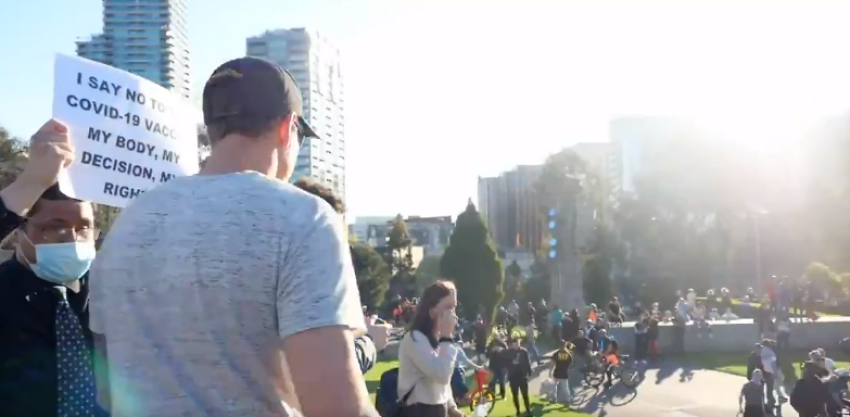
The mainstream commentary about the almost daily anti-vaccination rallies this week, after the attack on the Construction, Forestry, Mining and Energy Union (CFMEU) offices on September 20, has avoided analysing the complex motivations of the demonstrators, or suggesting sensible ways of responding.
The loudest of the corporate media hacks, Andrew Bolt and Ben Schneiders, claim the protests are the result of the supposed “bully boy”, “up yours” culture of the CFMEU.
Schneider’s description of CFMEU Victorian secretary John Setka as “a proud Croatian-Australian with a thirst for revenge” verges on racism. Setka is also being vilified for allegedly changing his mind on the union’s position, which is to encourage vaccination but not support making it mandatory for the industry.
Others have suggested that CFMEU members at the protests were dupes of the far right.
Not only are these anti-union commentators wrong, they don’t explain why so many people — predominately young and male — are so angry and why they have been drawn to the protests.
The attack on the CFMEU office was organised by the far right to stoke anti-vax fears among a layer of construction workers. Some construction workers were there because they had walked off their jobs after not being able to have lunch in their site sheds, another protest the corporate media failed to accurately report.
The group that assembled outside the CFMEU office was leaderless and politically diverse, but it did include some anti-union, anti-communist ring leaders. The chants ranged from “Stop the jab” to “Shut it down”, referring either to the construction industry or the CFMEU offices.
Many appeared confused. Some wanted to hear what Setka had to say, while others were determined to shut him down.
As the protest dragged on, and many had started to drink or become bored, violence started and the far right became more identifiable.
Attending the following days’ protests were people who were confused and angry. The live feed from real Rukshan Live on September 22 revealed that most were young, male and seemingly apolitical, although they are clearly upset that their rights are being violated. Their abstract notion of freedom is made concrete by being against vaccinations and government interference. They look proud to have taken a stand.
Their heightened sense of grievance makes them easy prey for the far right’s simplistic, anti-authority and individualist solutions. The far right is seeking to claim that unions support their cause, including publishing a flyer claiming a number of unions supported the September 18 anti-lockdown protest. The CFMEU, Australian Manufacturing Workers' Union, Victorian Trades Hall and other unions had to confirm that they did not.
Josh Roose, a Deakin University researcher writing for The Conversation on September 21, said: “Far right nationalists, anti-vaxxers, libertarians and conspiracy theorists have come together over COVID.” They have “capitalised on the anger and uncertainty simmering in some sections of the community … particularly among men who feel alienated, fearful about their employment” and spend a lot of time on social media.
“These movements thrive on anxiety, anger, a sense of alienation, a distrust in government and institutions. It’s really no coincidence this is occurring most vigorously in Melbourne given what this city has been through with lockdowns”, Roose wrote.
Most of his solutions, however, are too abstract: making politicians “lead” and “rebuilding trust” in them, and the need to “regulate” social media.
Equally unhelpful are those calling for the protesters to be identified and sacked from their jobs. This will create a witch-hunt climate, intensify these workers’ grievances and fueling the right’s efforts to paint union leaderships as simply being an arm of government.
A better way forward would involve getting people back to work safely and effectively. Employers need to implement all the correct safety procedures, not just rely on masks and vaccinations.
The Victorian government report on September 23 that the number of infections was rising in the construction industry proves that standards have slipped. Under occupational health and safety laws employers have a duty to keep the site safe; that is not the responsibility of individual workers.
Regarding vaccinations, the main campaigns need to focus on education and provide greater access. Mandating reluctant workers to get vaccinated will only lead them to the far-right, individualistic conspiracy types, or worse.
The federal and state governments’ roadmaps to reopening the economy are based on 70-80% of the population being double vaccinated. Yet, construction workers are told its 100% for them. Of course, this contradiction feeds any grievance.
If governments want a critical industry to remain open, they need to consult with the unions involved. They also need to help with education and training about COVID-19 safety, and with vaccination. This should include making vaccination readily available on the job and providing rapid on-the-job testing.
Unions do have an important role to play to address reactionary, anti-working class and anti-union ideas. Many, like the CFMEU, have strong delegate structures and young activists groups. They need to train their members politically, including having discussions about how to combat racism, sexism and other anti-worker ideologies.
Too often unions abrogate this important aspect of unionism, leaving workers to receive their political “education” from the likes of shock-jock Alan Jones or News Corps' Rupert Murdoch.
Unions today are very diverse and it is this diversity that gives them the ability to develop new layers of leadership in open, collective forums where criticism is seen as constructive and all voices are valued.
That diversity needs to be reflected in the union leadership and among the organisers. Too often, young workers feel alienated from unions. It is very important that unions fight to get a hearing among all the other pressures and demands upon these young workers.
These last few days of angry rallies need to be understood as an indicator of worse to come if union leaderships don’t fight to win a hearing about real fairness, equality and solidarity.